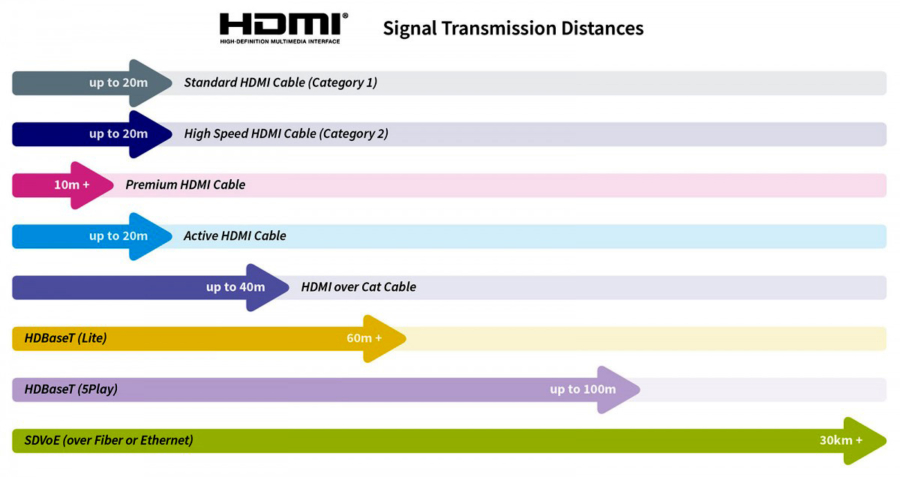In this article:
- How far can an HDMI signal transmit?
- What distance does HDMI cable support?
- Is there a standard HDMI cable length limit?
- Are expensive HDMI cables necessary?
How far can an HDMI signal transmit?
HDMI (High Definition Multimedia Interface), the combined HD video and audio signal standard, is now the most commonly used cable interface for residential, home theatre and commercial AV systems.
Most commonly, a HDMI cable is used to connect a HD or 4K UHD Source (such as a BluRay player or your Sky TV Box) directly to an adjacent TV, therefore a standard 3 metre HDMI lead distance would easily cover that short distance from one device to the other on the TV stand.
As we see more and more wall-mounting of TVs and screens, digital signage and video walls becoming increasingly commonplace, the distance between source and display can quickly increase to significantly great lengths. For instance, when running a cable from a source to TV through the wall or ceiling, the length of the cable run can very quickly exceed long distances of 15-20 metres and, therefore, stretch beyond the recommended capabilities of hdmi transmission.
What distance does HDMI cable support?
HDMI Category 1 – also referred to as Standard HDMI cable, will easily reach up to 5 metres without any problems and will transmit over distances of up to 20 metres.
Caution – before running any longer cable distances through walls or ceilings, etc – test your system first!
Use the exact Source-Cable-Display (plus any additional devices such as video switches, splitters, etc) to confirm the system works before installing.
For a signal that needs to travel further than 5 – 10 metres, a higher grade Category 2 (or High Speed) cable is recommended and will successfully achieve a signal distance of up to 15-20 metres.
It is also supports transmission of 4k UHD, 3D and Deep Colour video signals.
It isn’t possible to give the exact capabilities of each cable type, due to the wide range of factors that can affect signal transmission. Quality of cable and manufacture will affect signal capabilities, for example, as will the resolution (and, therefore, bandwidth) of the signal you’re transmitting. Environmental factors can also have a significant effect on signal interference and the distance of transmission.
However, there are some general guidelines on HDMI cable distance limitations. The below diagram gives the comparative range of each cable standard, as well as distance capabilities of alternative Ethernet cable and over-IP transmission options such as video-over-Ethernet cable, HDBaseT and SDVoE (video-over-IP technology) which allow for HD, 4k UHD audio-video signals to be transmitted over longer distances.
Are expensive HDMI cables necessary?
High Definition Multimedia Interface is a digital signal transmitting zeros and ones. This means that the cable should, in theory, either work or it won’t. However, signals can and will often be affected by factors such as:
Transmission distance
Higher resolutions
Interference from other electrical/electronic devices
Environmental factors
Cable quality
In most cases for simple device-to-device connectivity, there is simply no need to spend vast amounts on HDMI leads, however, likewise, don’t go too cheap.
Is there a standard HDMI cable length limit?
It isn’t possible to give the exact capabilities of each cable type, due to the wide range of factors that can affect signal transmission. Quality of cable and manufacture will affect signal capabilities, for example, as will the resolution (and, therefore, bandwidth) of the signal you’re transmitting. Environmental factors can also have a significant effect on signal interference and the distance of transmission.
However, there are some general guidelines on HDMI cable distance limitations. The below diagram gives the comparative range of each cable standard, as well as distance capabilities of alternative Ethernet cable and over-IP transmission options such as video-over-Ethernet cable, HDBaseT and SDVoE (video-over-IP technology) which allow for HD, 4k UHD audio-video signals to be transmitted over longer distances.
Transmission distance
Higher resolutions
Interference from other electrical/electronic devices
Environmental factors
Cable quality
In most cases for simple device-to-device connectivity, there is simply no need to spend vast amounts on HDMI leads, however, likewise, don’t go too cheap.

Are expensive HDMI cables necessary?
High Definition Multimedia Interface is a digital signal transmitting zeros and ones. This means that the cable should, in theory, either work or it won’t. However, signals can and will often be affected by factors such as:
- Transmission distance
- Higher resolutions
- Interference from other electrical/electronic devices
- Environmental factors
- Cable quality
In most cases for simple device-to-device connectivity, there is simply no need to spend vast amounts on HDMI leads, however, likewise, don’t go too cheap.